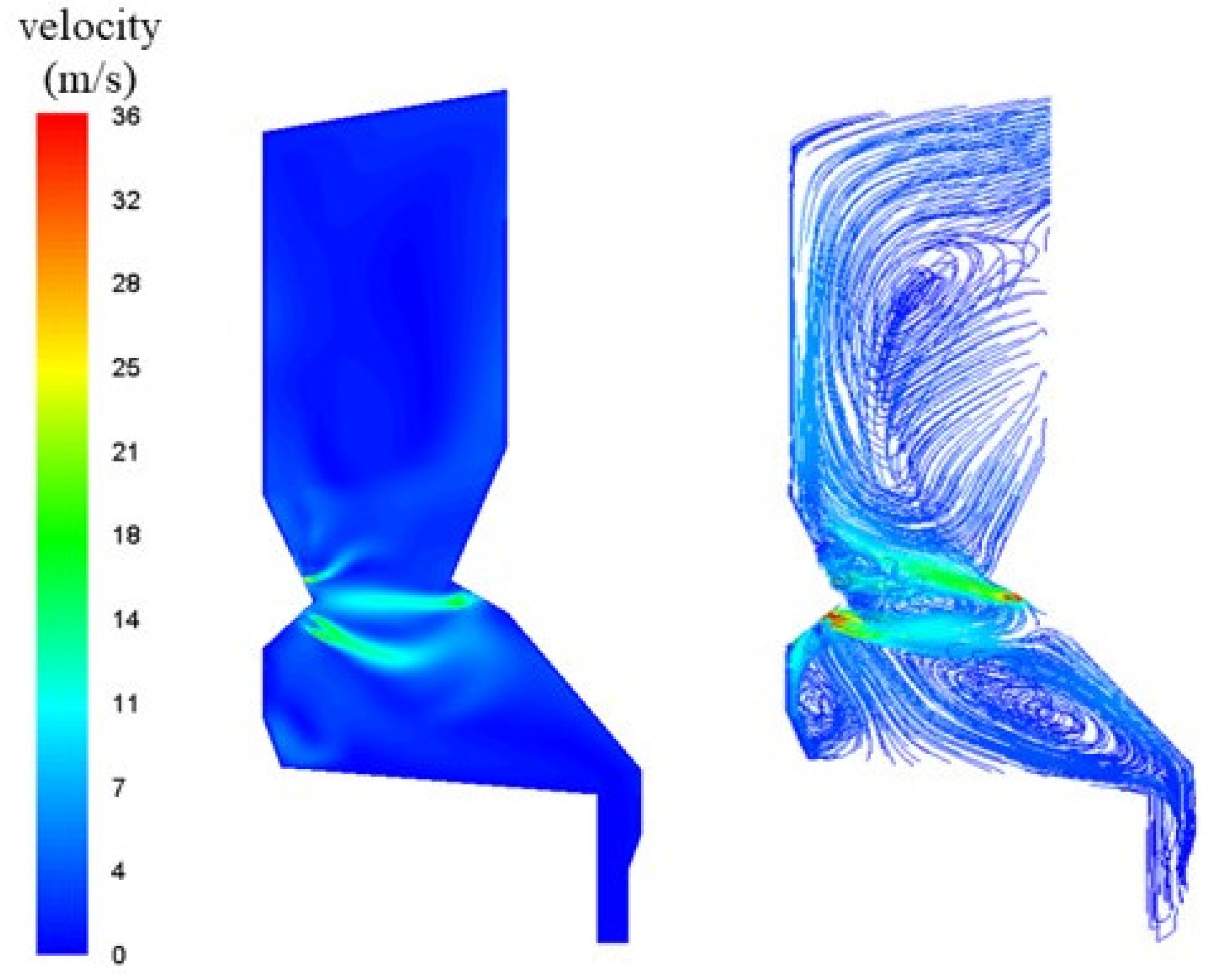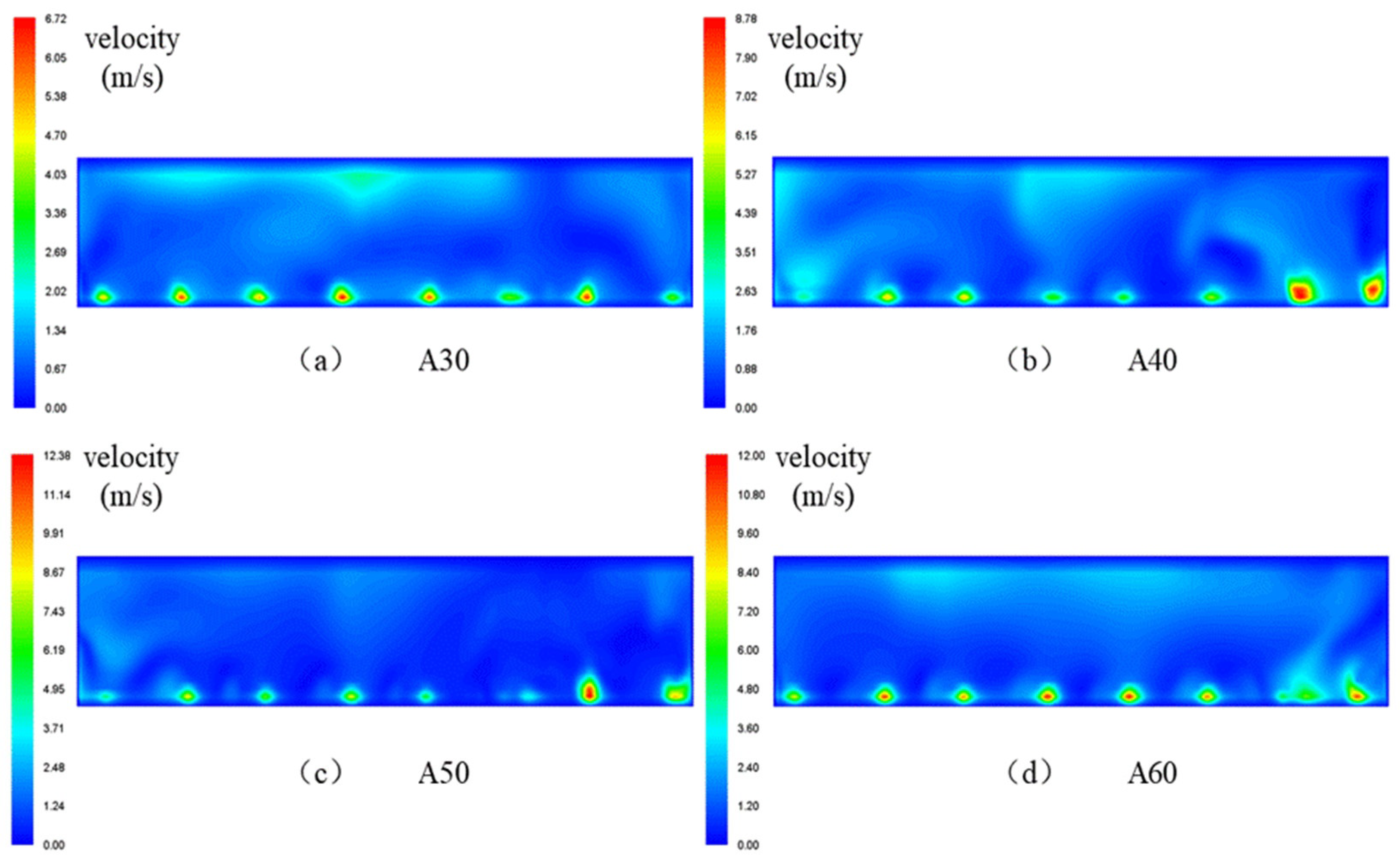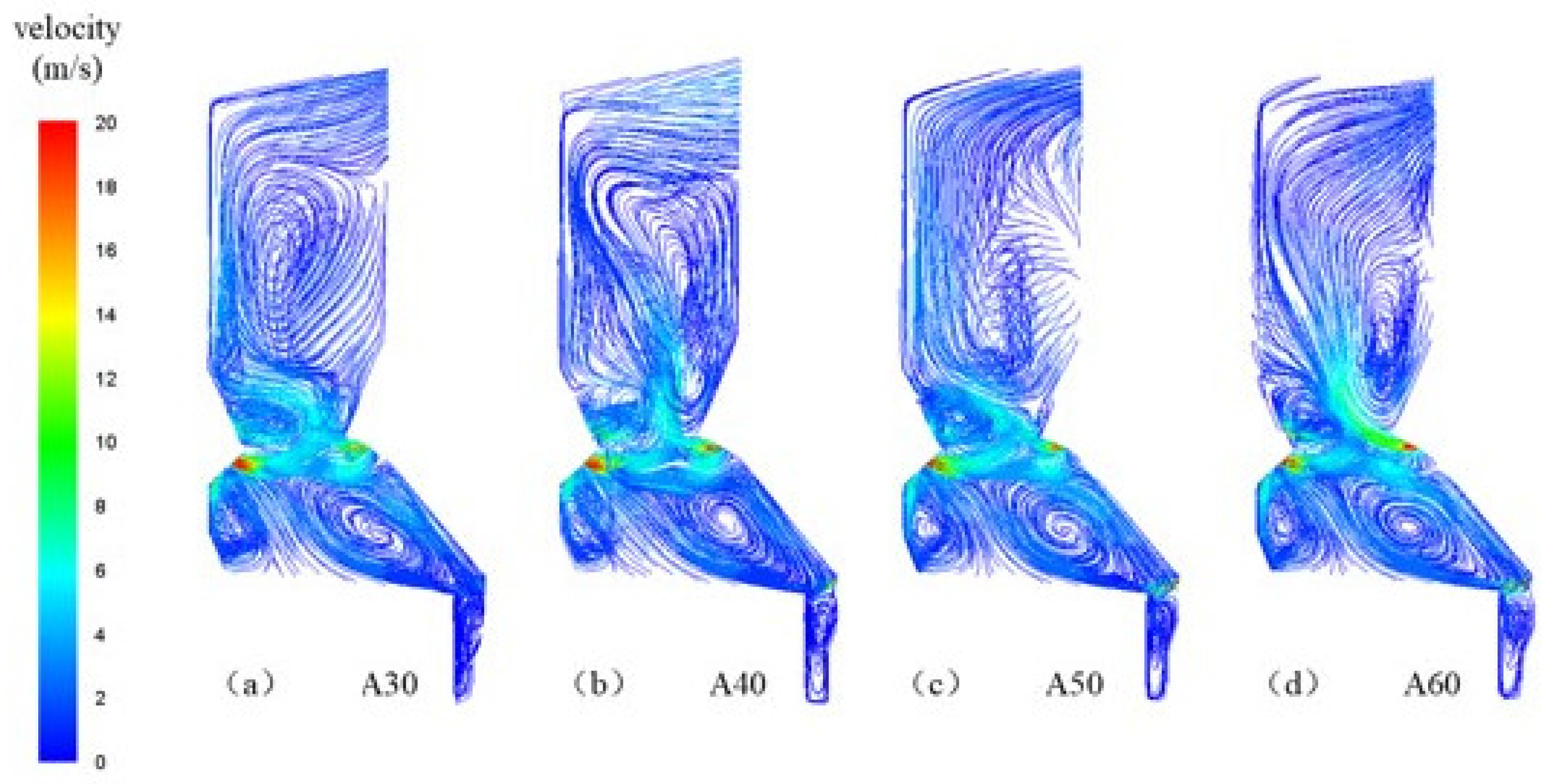Numerical Simulation of Tail Over-Fire Air Supply of a Grate Biomass Boiler
Abstract
:1. Introduction
2. Methodology
2.1. Physical Properties of the Grate Boiler
2.2. Numerical Model
2.3. Assumptions and Boundaries
- (1)
- In the original air distribution system working condition (0), the primary air ratio is 30%; the front wall upper, middle, and lower secondary air speeds are, separately, 32 m/s, 50 m/s, and 36 m/s.
- (2)
- The back wall secondary air speed is 57 m/s.
- (3)
- Model port setting: The flow inlet: the lower primary air outlet of the grate.
- (4)
- The speed inlet: each secondary air outlet of the furnace; the pressure outlet: furnace outlet.
- (5)
- The total air volume of the air distribution system is constant.
- (6)
- The maximum ratio of burnout air is limited at 7.3%.
3. Analysis and Discussion
3.1. The Air Distribution System without Tail Burnout Air
3.2. Different Outlet Velocities of Grate Burnout Air
3.3. Different Pipe Diameters of Grate Burnout Air
3.4. Different Jet Angles of Grate Burnout Air
4. Conclusions
- (1)
- Adding burnout air at the tail of the grate can improve the airflow velocity at the tail of the grate, strengthen the disturbance of the flow field, and enhance the radiation and convection heat transfer in the furnace. It can create a good combustion condition for the unburned carbon on the grate tail. The high-speed burnout air can blow some particles back to the high-temperature combustion zone and prolong the residence time of particles on the grate. This phenomenon is due to the improvement of the combustion efficiency in the furnace and the reduction of carbon content in the slag.
- (2)
- When the number of burnout air ducts at the tail of the furnace row is certain, increasing the wind speed of burnout air or expanding the diameter of burnout air can effectively improve the airflow velocity at the tail of the furnace row, increase the disturbance degree of the flow field in this area, and increase the proportion of particle reduction on the grate tail. Therefore, under the assumption of the maximum proportion of burnout air volume, the outlet velocity and the pipe diameter of burnout air should be increased as much as possible under the boundary conditions.
- (3)
- When the down dip angle of the burnout wind changes, the air velocity at the tail of the furnace row increases within 1 m/s, but the upper flow field is improved to a certain extent. In order to obtain a greater air velocity and to increase the turbulence degree of the flow field at the grate tail, the down dip angle of the burnout wind can be set at between 11–13°.
Author Contributions
Funding
Conflicts of Interest
References
- Wang, F.; Liu, X.; Chen, L.G. Research status and development prospect of energy and high value utilization of biomass resources. Trans. Chin. Soc. Agric. Eng. 2021, 37, 219–231. [Google Scholar]
- International Energy Agency. World Energy Outlook 2018. 2018. Available online: https://www.iea.org/weo2018/ (accessed on 13 November 2018).
- Sánchez, J.; Curt, M.D.; Robert, N.; Fernández, J. Chapter two biomass resources. In The Role of Bioenergy in the Emerging Bioeconomy, Resources, Technologies, Sustainability and Policy; Lago, C., Caldes, N., Lechon, Y., Eds.; Academic Press: Cambridge, MA, USA, 2019; pp. 2–111. [Google Scholar] [CrossRef]
- Ismail, T.M.; Abd El-Salam, M.; El-Kady, M.A.; El-Haggar, S.M. Three dimensional model of transport and chemical late phenomena on a MSW incinerator. Int. J. Therm. Sci. 2014, 77, 139–157. [Google Scholar] [CrossRef]
- Demirbas, A. Potential applications of renewable energy sources, biomass combustion problems in boiler power systems and combustion related environmental issues. Prog. Energy Combust. Sci. 2005, 31, 171–192. [Google Scholar]
- Lv, Y.; Jiang, D.L.; Zhao, W.J.; Liu, J.Z. Technology of Biomass Direct Combustion Power Generation and Combustion Analysis. Power Syst. Eng. 2011, 27, 4–7. [Google Scholar]
- Zhang, J.H. Numerical Simulation of Combustion Characteristics and NOx Emission of Biomass Grate Furnace. Master’s Thesis, South China University of Science and Engineering, Guangzhou, China, 2020. [Google Scholar]
- Sun, R.; Ismail, T.M.; Ren, X.H.; El-Salam, M.A. Numerical and experimental studies on effects of moisture content on combustion characteristics of simulated municipal solid wastes in a fixed bed. Waste Manag. 2015, 39, 166–178. [Google Scholar] [CrossRef] [PubMed]
- Sun, R.; Ismail, T.M.; Ren, X.H.; El-Salam, M.A. Influence of simulated MSW sizes on the combustion process in a fixed bed: CFD and experimental approaches. Waste Manag. 2016, 49, 272–286. [Google Scholar] [CrossRef] [PubMed]
- Gómez, M.A.; Porteiro, J.; de la Cuesta, D.; Patiño, D.; Míguez, J.L. Numerical simulation of the combustion process of a pellet-drop-feed boiler. Fuel 2016, 184, 987–999. [Google Scholar] [CrossRef]
- Kaer, S.K. Numerical modeling of a straw-fired grate boiler. Fuel 2004, 83, 1183–1190. [Google Scholar] [CrossRef]
- Zhou, A.; Xu, H.; Tu, Y.; Zhao, F.; Zheng, Z.; Yang, W. Numerical investigation of the effect of air supply and oxygen enrichment on the biomass combustion in the grate boiler. Appl. Therm. Eng. 2019, 156, 550–561. [Google Scholar] [CrossRef]
- Hu, Y.M.; Wu, C.B.; Zhu, X.C.; Shao, Y. Optimization and numerical simulation of secondary air induction into refuse incinerator. J. Environ. Eng. 2009, 3, 951–955. [Google Scholar]
- Liu, R.M.; Liu, Y.K.; Wang, Z.H.; Liu, Y.-Z. CFD simulation and optimization of secondary air distribution for waste combustion in grate furnace. J. Zhejiang Univ. (Eng. Sci.) 2017, 51, 500–507. [Google Scholar]
- Lu, Y.; Zhang, H.; Xu, Y.; Zhu, Y.; Wan, K.; Shao, Z.; Wang, Z. Numerical simulation of effects of flue gas recirculation on biomass combustion in grate boiler. J. Zhejiang Univ. (Eng. Sci.) 2019, 53, 1898–1906. [Google Scholar]








| % | Q (kJ/kg) | ||||
|---|---|---|---|---|---|
| C | H | O | N | S | |
| 36.25 | 6.16 | 28.97 | 0.38 | 0.13 | 10,332 |
| Design Parameters | |
|---|---|
| Main steam flow (t/h) | 130 |
| Main steam pressure (MPa) | 9.18 |
| Main steam temperature (°C) | 538 |
| Feed water temperature (°C) | 220 |
| The primary air temperature (°C) | 200 |
| The secondary air temperature (°C) | 200 |
| The ratio of the primary and secondary air | 3:7 |
| Numbers | Primary Air (%) | Lower Secondary Air on Front Wall (%) | Middle Secondary Air on Front Wall (%) | Upper Secondary Air on Front Wall (%) | Secondary Air on Back Wall (%) | Tail Burnout Air on Grate (%) | Outlet Velocity of Grate Burnout Air (M/S) |
|---|---|---|---|---|---|---|---|
| 0 | 30 | 8 | 25 | 14 | 23 | - | - |
| A30 | 30 | 8 | 25 | 14 | 21.35 | 1.65 | 30 |
| A40 | 30 | 8 | 25 | 14 | 20.8 | 2.2 | 40 |
| A50 | 30 | 8 | 25 | 14 | 20.25 | 2.75 | 50 |
| A60 | 30 | 8 | 25 | 14 | 19.7 | 3.3 | 60 |
| B60 | 30 | 8 | 23 | 14 | 20 | 5 | 60 |
| C60 | 30 | 8 | 22 | 13 | 19.7 | 7.3 | 60 |
| Numbers | Burnout Air Pipe Diameter (mm) | Average Velocity of Gas Flow at the Grate Tail (m/s) |
|---|---|---|
| A30 | 76 | 2.50 |
| A40 | 76 | 2.78 |
| A50 | 76 | 3.40 |
| A60 | 76 | 4.79 |
| Numbers | Burnout Air Pipe Diameter (mm) | Average Velocity of Gas Flow at the Grate Tail (m/s) | Ratio (%) | Ratio of Particle Quantity Reduction (%) |
|---|---|---|---|---|
| A50 | 76 | 3.4 | 0 | 4.76 |
| B50 | 89 | 4.53 | 33 | 5.36 |
| C50 | 108 | 5.08 | 49 | 7.53 |
| A60 | 76 | 4.85 | 0 | 7.74 |
| B60 | 89 | 5.45 | 12 | 8.33 |
| C60 | 108 | 6.00 | 24 | 10.42 |
| Incident Angle (°) | Average Velocity of Gas Flow at the Grate Tail (M/S) |
|---|---|
| 10 | 6.96 |
| 11 | 7.03 |
| 12 | 6.60 |
| 13 | 6.86 |
| 14 | 5.87 |
| 15 | 6.00 |
Publisher’s Note: MDPI stays neutral with regard to jurisdictional claims in published maps and institutional affiliations. |
© 2022 by the authors. Licensee MDPI, Basel, Switzerland. This article is an open access article distributed under the terms and conditions of the Creative Commons Attribution (CC BY) license (https://creativecommons.org/licenses/by/4.0/).
Share and Cite
Chi, S.; Liang, Y.; Chen, W.; Hou, Z.; Luan, T. Numerical Simulation of Tail Over-Fire Air Supply of a Grate Biomass Boiler. Energies 2022, 15, 7664. https://doi.org/10.3390/en15207664
Chi S, Liang Y, Chen W, Hou Z, Luan T. Numerical Simulation of Tail Over-Fire Air Supply of a Grate Biomass Boiler. Energies. 2022; 15(20):7664. https://doi.org/10.3390/en15207664
Chicago/Turabian StyleChi, Shidan, Yan Liang, Weixi Chen, Zhen Hou, and Tao Luan. 2022. "Numerical Simulation of Tail Over-Fire Air Supply of a Grate Biomass Boiler" Energies 15, no. 20: 7664. https://doi.org/10.3390/en15207664




